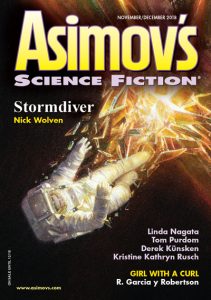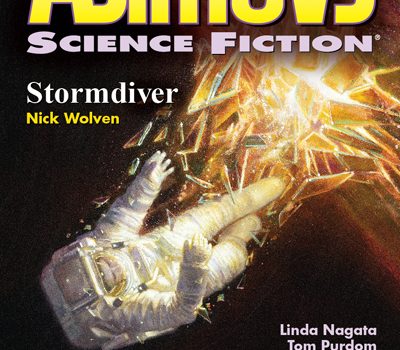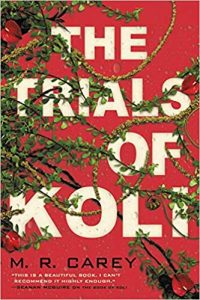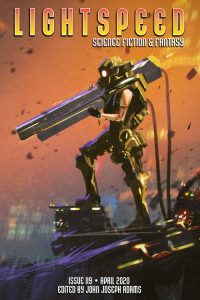Rich Horton Reviews Short Fiction: Asimov’s, Analog, Robots vs Fairies, The Book of Magic, and An Agent of Utopia
 Asimov’s 11-12/18
Asimov’s 11-12/18
Analog 11-12/18
Robots vs Fairies, Dominik Parisien & Navah Wolfe, eds. (Saga Press) January 2018.
The Book of Magic, Gardner Dozois, ed. (Bantam) October 2018.
An Agent of Utopia, Andy Duncan (Small Beer Press) December 2018.
The stories in the final 2018 issue of Analog that worked best for me seem also exemplars of “Analog being Analog” – pure SF extrapolation, both near-future gadget stuff and far-future near-mystical stuff. In Tom Jolly‘s “Learning the Ropes“, which adds a side item of good old Analog-style space boosterism, we have a future in which space commerce is tied up by the Solar Resources Commission, a monopoly, which among other things is suppressing real colonization effort, and we have an entrepreneur and scientific whiz, one Mari Doromuala, who had to leave her home in the Solomon Islands due to climate change, and who would like to change Mars’s climate enough to make it habitable. The gadgety idea is using tethers to spin pairs of asteroids – ostensibly for energy production, but in reality – you’ll have guessed it – to subtly target Mars. It’s fun stuff, if a bit thin, depending for one thing on a lucky choice of SRC observer – I liked it, if I didn’t quite believe it. Also near-future, C. Stuart Hardwick‘s “A Measure of Love” is a sweet story about an orphan girl rescuing the robot who raised her and her fellow orphans, before being excessed – and finding that the robot has a hard time adapting to not being a parent figure.
Christopher McKitterick‘s “Ashes of Exploding Suns, Monuments to Dust” takes us 15,000 years after the extinction of the inhabitants of Karalang, a system of long-lived posthumans who prided themselves on their discipline, their form of outer-directed honor, and on their engineering feats, such as steering their sun around the galaxy. Their stunt drew the ire of the Original Men, still on Earth, who destroyed them. Millennia later, the few survivors who hid away in an asteroid are ready to destroy the Sol System in revenge. Ultimately, though, is revenge 15,000 years later truly the honorable path? The answer is obvious – more interesting is the imagined far future, and the imagined society.
In Asimov’s, Julia Novakova‘s “The Gift” also features long-lived humans and revenge. The title gift was received from a mysterious alien probe, and it allowed a randomly selected group of humans indefinitely extended lifespans. One of these long-lived people, on a planet around Epsilon Eridani, hires a young woman to track down another immortal, who is rumored to be at Van Maanen’s Star. But for what reason? Flashbacks to the immediate aftermath of the alien Gift and the violence that resulted suggest one possibility, but the immortal at Van Maanen’s Star is after something different – a solution to the mystery of the aliens, and where they came from and where they’ve gone. Again, the story’s moral, well enough expressed as it is, is less involving than the sheer sense of mystery and wonder the story evokes.
Another sort of mystery is at the heart of “Incident at San Juan Bautista” by Ray Nayler. In Old West San Juan Bautista, August Sutherland, German immigrant turned dentist turned hired killer, is preparing for his latest assignment. He is fascinated by a woman in the saloon and obtains her services, but she is a much stranger creature than your standard-issue beautiful Western movie whore, as August learns when she first extracts from him his story, then tells him as much of hers as he can understand. SF readers will have ideas about what or who she is – but the story doesn’t really reveal that in detail, just shows the eerie results of her particular pastime. Cool stuff.
Robots vs Fairies reminds me of the Holly Black & Justine Larbalestier anthology Zombies vs. Unicorns from a few years ago. The conceit is alternating stories from “Team Robot” and “Team Fairy”, with afterwords by the authors explaining their choices. And, like the previous anthology, where my favorite story was Garth Nix’s tale of a zombie unicorn, some of the best pieces here actually combine the two themes, as with Seanan McGuire‘s “Build Me a Wonderland“, about creatures of Faery (loosely constructed) coming to a Disneyland sort of place to help maintain the park, and to provide live fairies and mermaids, etc., to replace the animatronic (i.e. robot) originals; or Annalee Newitz‘s “The Blue Fairy’s Manifesto“, set in the future of her novel Autonomous, and featuring a robot calling itself the Blue Fairy setting free other robots, including in this story a robot RealBoy. McGuire’s story is clever and enjoyable; Newitz’s is more interesting (to me), reiterating some of the themes of Autonomous in asking what freedom really might mean for robots.
Even better is “Work Shadow/Shadow Work” by Madeline Ashby, set in Iceland, about a robotic “home care assistant” working for an older woman who claims to be a witch. Her daughter, who bought her the assistant, is skeptical. The story is told through the POV of the assistant – who is compelled to work with his client, the witch, as she negotiates with elves (maybe) about a road project – and as she comes to, perhaps just a bit, appreciate the assistant’s effort. And there’s another robot-oriented take on Pinocchio: Lavie Tidhar‘s “The Buried Giant“. This is set in “the Land,” which seems to be a post-apocalyptic enclave, where a small human community lives very simple lives. The frame is set there, with two children begging to hear the story of a town rumored to exist in the wasteland outside the “Land.” They are told it by two of the older residents: there was a town once, apparently run by robots for the purpose of raising one human boy, but the boy realizes he’s not like everyone else and runs away, wanting to become a “real boy,” i.e., a robot. He has dangerous adventures, meeting a robot cat and a robot fox, a dead girl and a manshonyagger (I always like the odd Cordwainer Smith reference!) and others. It’s lovely and moving and perfectly framed. The rest of the book is also very strong, with nary a bad story in it. I’ll mention in particular a powerful Sarah Gailey story, and a very funny John Scalzi piece (and afterword).
Gardner Dozois’s final (I presume) original anthology, The Book of Magic, is here, and it lives up to the high standards set by his previous work. The best work includes “Flint and Mirror” by John Crowley, framed as notes for a novel by Fellowes Kraft (a character from his Aegypt sequence). The story concerns Hugh O’Neill, heir to the throne of Ulster, and his upbringing, first in Ireland, and then in England (for political reasons), where he meets the alchemist Dr. John Dee. He finds himself set between two enemies (and their magic): the “old ones” in Ireland, and the Queen of England. Eleanor Arnason‘s “Loft the Sorcerer” cannily retells an Icelandic folktale, about a man tempted into black sorcery and his scary encounter with a troll maid and an elf queen. Liz Williams‘ “Sungrazer” is an effectively mysterious story of a retired astronomer who is also secretly a magician, and his encounter with a sort of fire spirit, which leads him to negotiate with living stars to save the Earth from a comet. Garth Nix, in “The Staff and the Stone“, tells of a wizard who has come to country demesne to live quietly, and who is asked to help solve the problem of what seems to be a wizard’s staff embedded in the border stone between some of the local villages. This results in an encounter with some dangerous entities – none more so than the wizard who is behind the mischief, a woman he had known in their school days. Andy Duncan offers his third Pearleen Sunday story, “The Devil’s Whatever“, in which Pearleen, a wizard based in Appalachia, is finagled into helping her friend, the Devil’s son-in-law Petey Wheatstraw, out of a fix involving places named after the Devil.
Speaking of Andy Duncan, An Agent of Utopia is a very welcome new collection from him. It includes some of his best earlier stories, and opens with two brand new pieces, both very good. “An Agent of Utopia” is set in London in 1535, with Thomas Moore waiting to be executed, but he has a surprising visitor – a man from Utopia, the subject of Moore’s famous book. This man’s job is to free Moore and take him back with him – but Moore refuses. Then the story turns to a real event – Moore’s eldest daughter, the celebrated writer Margaret Roper, arranged to steal his head from the spike it was displayed on. Here she turns to the man from Utopia, who for all his Utopian background, finds himself smitten and unable to refuse her. The other new piece is “Joe Diabo’s Farewell“, told by Eddie Two Rivers DeLisle, a Mohawk working the high steel. It follows him through one day, marked by an accident in which Joe Diabo, a veteran worker and one of the few Mohawks sticking with the “old ways,” falls to his death. Eddie, given the day off and grieving, ends up picking up some extra money acting as a “real Indian” for the premier of a new movie about Custer. And in so doing encounters a real General who was at Little Big Horn, a pretty girl who seems to like him, and a bunch of the other “real Indians,” who are every sort of ethnicity except for Native American… but who are his kin anyway. One more encounter with Joe Diabo closes the story, which is lovely and hard to describe – carried by voice, and character, and a perhaps paradoxical groundedness, given that much of it is set 30 stories in the sky. These two stories, along with “The Devil’s Whatever”, represent very well one of Duncan’s greatest strengths: all are steeped in the voice of their characters (and tellers), yet all three (or four) voices are completely different, and completely effective.
Recommended Stories
“Work Shadow/Shadow Work”, Madeline Ashby (Robots vs. Fairies)
“Flint and Mirror”, John Crowley (The Book of Magic)
“Joe Diabo’s Farewell”, Andy Duncan (An Agent of Utopia)
“An Agent of Utopia”, Andy Duncan (An Agent of Utopia)
“Ashes of Exploding Suns, Monuments to Dust”, Christopher McKitterick (Analog 11-12/18)
“Incident at San Juan Bautista”, Ray Nayler (Asimov’s 11-12/18)
“The Blue Fairy’s Manifesto”, Annalee Newitz (Robots vs. Fairies)
“The Staff in the Stone”, Garth Nix (The Book of Magic)
“The Gift”, Julia Novakova (Asimov’s 11-12/18)
“The Buried Giant”, Lavie Tidhar (Robots vs. Fairies)
“Sungrazer”, Liz Williams (The Book of Magic)
Rich Horton works for a major aerospace company in St. Louis MO. He has published over a dozen anthologies, including the yearly series The Year’s Best Science Fiction and Fantasy from Prime Books, and he is the Reprint Editor for Lightspeed Magazine. He contributes articles and reviews on SF and SF history to numerous publications.
This review and more like it in the December 2018 issue of Locus.
 While you are here, please take a moment to support Locus with a one-time or recurring donation. We rely on reader donations to keep the magazine and site going, and would like to keep the site paywall free, but WE NEED YOUR FINANCIAL SUPPORT to continue quality coverage of the science fiction and fantasy field.
While you are here, please take a moment to support Locus with a one-time or recurring donation. We rely on reader donations to keep the magazine and site going, and would like to keep the site paywall free, but WE NEED YOUR FINANCIAL SUPPORT to continue quality coverage of the science fiction and fantasy field.








